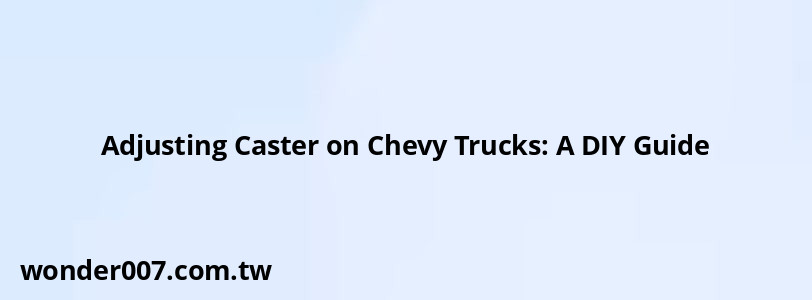Adjusting Caster on Chevy Trucks: A DIY Guide

Adjusting the caster on your Chevy truck is crucial for optimal handling and tire wear. This guide will walk you through the process of caster adjustment, ensuring your truck performs at its best.
Understanding Caster
Caster refers to the angle of the steering axis when viewed from the side of the vehicle. Proper caster alignment is essential for steering stability and self-centering of the steering wheel.
Importance of Correct Caster
- Improves straight-line stability
- Enhances cornering performance
- Reduces steering effort
- Promotes even tire wear
Tools Needed for Caster Adjustment
Before starting, gather these essential tools:
- Floor jack and jack stands
- Wrench set
- Socket set
- Caster/camber gauge
- Pry bar
- Torque wrench
Adjusting Caster on Chevy Trucks
Follow these steps to adjust the caster on your Chevy truck:
Preparation
1. Park your truck on a level surface and engage the parking brake
2. Lift the front of the truck using a floor jack and secure it with jack stands
3. Remove the front wheels for better access to suspension components
Locating Adjustment Points
On most Chevy trucks, caster is adjusted at the upper control arm. Look for:
- Cam bolts on the upper control arm
- Adjustment slots on the frame where the control arm attaches
Making the Adjustment
1. Loosen the upper control arm bolts
2. Use a pry bar to move the control arm forward or backward
3. Moving the upper ball joint forward increases positive caster
4. Moving it backward decreases positive caster
Measuring and Fine-Tuning
1. Use a caster/camber gauge to measure the caster angle
2. Aim for a caster angle between 3 to 5 degrees positive for most Chevy trucks
3. Make small adjustments and re-measure until the desired angle is achieved
Finalizing the Adjustment
1. Once the correct caster is set, tighten all bolts to the manufacturer's specified torque
2. Recheck the caster angle after tightening
3. Reinstall the wheels and lower the vehicle
Tips for Successful Caster Adjustment
- Always consult your Chevy truck's service manual for specific specifications
- Adjust both sides of the vehicle, even if only one side seems off
- Be patient and make small, incremental adjustments
- Consider professional alignment if you're unsure about the process
Verifying the Adjustment
After adjusting the caster:
1. Take your truck for a test drive
2. Check for improved steering stability and self-centering
3. Monitor tire wear patterns over time
Remember, caster adjustment is just one part of a complete wheel alignment. For optimal performance, consider adjusting camber and toe as well.
FAQs About Adjusting Caster on Chevy Trucks
- How often should I check my truck's caster?
Check caster annually or when you notice steering issues or uneven tire wear. - Can I adjust caster without special tools?
While possible, it's not recommended. Proper tools ensure accurate measurements and adjustments. - Will adjusting caster affect my truck's ride height?
Caster adjustment typically doesn't affect ride height, but it may slightly change the wheel's position in the wheel well.
By following this guide, you can successfully adjust the caster on your Chevy truck, improving its handling and extending tire life. Remember to work safely and seek professional help if you encounter any difficulties during the process.
Related Posts
-
Chevy Cruze 1.4 Spark Plug Gap: Essential Guide
29-01-2025 • 68 views -
Left Sunroof Open in Rain: Quick Fix Guide
29-01-2025 • 76 views -
Hyundai Elantra 2014: Comprehensive Headlight Bulb Guide
30-01-2025 • 71 views -
Cadillac CTS Key Fob Programming: A Complete Guide
30-01-2025 • 80 views -
2003 Chevy Silverado 2500HD Power Steering Lines Diagram
31-01-2025 • 66 views
Latest Posts
-
Power Steering Fluid Leak On Passenger Side
01-02-2025 • 156 views -
2015 Chevy Traverse AC Recharge Port Location
01-02-2025 • 143 views -
Rear Brake Caliper Piston Won't Compress
01-02-2025 • 127 views -
Are O2 Sensors Covered Under Warranty
01-02-2025 • 132 views -
How To Turn Off Paddle Shifters Mercedes
01-02-2025 • 132 views
Popular Posts
-
2017 Ford Expedition Cabin Air Filter Guide
29-01-2025 • 218 views -
Linde Forklift Warning Light Symbols Explained
26-01-2025 • 215 views -
Cabin Air Filter: Essential Guide for 2009 Hyundai Elantra
29-01-2025 • 255 views -
Buick Verano: Years to Avoid for Buyers
26-01-2025 • 207 views -
PT Cruiser: Years to Avoid for Buyers
26-01-2025 • 294 views
